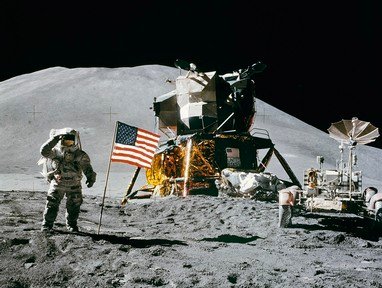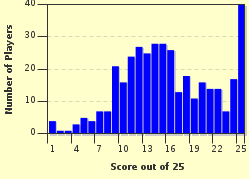Quiz Answer Key and Fun Facts
1. This astronaut will be forever remembered as the second man to walk on the moon.
2. The whole world remembers the inspired reading of passages from the Book of Genesis while Apollo 8 orbited the moon on Christmas Eve 1968. Who was the commander of Apollo 8?
3. Amid the euphoria when Armstrong announced that 'The Eagle has landed' mission control responded that there are 'lots of smiling faces in this room', to which Armstrong responded 'there are two of them up here'. Then there was a third call: 'And don't forget the one in the Command Module!' Who was this?
4. During the Apollo test programme each step of the moon landing was tested before moving on to the next stage. The Apollo 9 mission checked out the operation of the Lunar Module (LM) in earth orbit. In the mission planning sequence this was referred to as the '_' mission.
5. The mission patch of Apollo 11 depicts an _________ clutching an olive branch about to land on the moon.
6. Onboard electrical power for the Apollo Command and Service Module (CSM) was supplied by:
7. The key element which accomplished the moon landings was the ungainly looking Lunar Module (LM). Which company built the LM's?
8. Apollo 15 was the first of the extended capability 'J' missions and was targeted to land near _________.
9. During the launch of a Saturn V booster its trajectory was controlled by the Inertial Measuring Unit (IMU) located in the top of the S-IVB third stage.
10. Five of these engines powered the S-II second of the Saturn V and a single one powered the S-IVB third stage.
11. This man held the vital position of Director of Flight Operations during all of the Apollo missions.
12. What was the name of the rocket used to test the Apollo Launch Escape System (LES)?
13. Which of these NASA locations was responsible for the development of the Saturn V rockets?
14. During the early planning stages Project Apollo direct ascent was one of the options being considered to achieve a moon landing. This would have required the development of this truly gargantuan rocket.
15. "Houston, we've had a problem." was the ominous phrase which initiated a remarkable rescue operation when an explosion crippled Apollo 13. What was the name of the Command and Service Module (CSM) on which this explosion occurred?
16. The potentially fatal '__________' effect that could lead to the break-up of a Saturn launch vehicle was identified during the unmanned Apollo 5 test flight
17. At the very top of the Saturn V rocket under the rounded tip of the Launch Escape System (LES) was a device known as the Q-ball. What was its function?
18. Which of these flight profiles was chosen to accomplish the moon landings?
19. Which astronaut demonstrated one of Galileo's theories of gravitation on the moon using a hammer and a feather?
20. Which area was the target for the final Apollo 17 moon landing?
21. During staging of a Saturn V launch the second and third stages were given a slight push by __________ rockets before engine ignition in order to settle fuel over the outlets to ensure a smooth flow to the main engines.
22. Project Apollo would never have gotten off the ground without the vision and rocketry experience of the team led by:
23. Without the expertise and drive of NASA's second administrator in managing Project Apollo, President Kennedy's goal of landing a man on the moon before 1970 would not have been realised. Who was this?
24. Who was Commander of Apollo 16 and went on to become NASA's most experienced astronaut?
25. The descending countdown is an integral part of any rocket launch and was introduced by Wernher von Braun's team from their time while developing the V-2. The 'zero' point during an Apollo/Saturn countdown was when the main engines ignited.
Source: Author
mstanaway
This quiz was reviewed by FunTrivia editor
bloomsby before going online.
Any errors found in FunTrivia content are routinely corrected through our feedback system.

